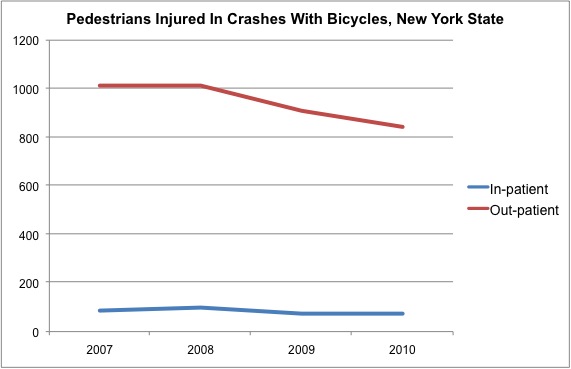Well, it didn't take long for our local media to mangle the Hunter College study measuring bike-on-ped injuries in New York state. Statewide hospital data compiled by professors Peter Tuckel and William Milczarik plainly show a drop in pedestrian injuries caused by cyclists between 2007 and 2010 -- the same period when NYC doubled the size of its bike network. Yet the Times headline read "Study Finds Higher Number of Pedestrians Hurt by Bikes," NY1 headlined its piece "More Pedestrians Being Hit By Bikes, Study Finds," and the Post led its coverage like so: "Maybe they should replace those bike lanes with ambulance lanes."
A more appropriate lede might have gone: "Maybe they should build those bike lanes faster." Because the injury data suggests, if anything, that bike-on-ped injuries are declining as bike infrastructure expands and more New Yorkers take up cycling.
The study's main contribution is to give a more accurate sense of how many pedestrians are injured by cyclists each year. To get a truly firm grip on the nature of the problem, it would also help to have more detailed information on the severity of the injuries. (The State DMV, for instance, breaks down motor vehicle-caused injuries into three different classes: serious, moderate, and minor.) But a key finding is that the number of these injuries was significantly lower in 2010 than in 2007 (927, down from 1097). Bike commuting into downtown Manhattan almost doubled in the same period.
Without access to the annual data that's specific to New York City and its boroughs (the Hunter study only breaks out annual figures for statewide data), it's hard to say with certainty that the city's bike-on-ped injuries are falling. But given that 55 percent of the state's injuries happen in NYC, it's reasonable to assume that the same year-over-year drop is happening at the city level too.
When you study traffic and street safety issues, you're bound to come across counterintuitive findings pretty often. Widening roads, for instance, makes traffic congestion worse. Designing streets to make drivers feel safe actually endangers them and everyone else around them. Cyclist injury rates fall as cycling rates rise.
We don't have enough data to know for sure, but maybe the bike-on-ped injury rate in NYC will also fall as the cycling rate rises. Several factors could explain why:
- The more cyclists are on the street, the more predictable their movements become to pedestrians.
- Infrastructure that makes cyclists feel safe on the street decreases the likelihood that they'll choose to bike on the sidewalk.
- As more people feel comfortable cycling, the general pool of cyclists stops skewing toward young, male risk-takers. The more risk-averse people who take up cycling engage in fewer behaviors that pose potential harm to pedestrians.
So the Hunter study offers some promising avenues of inquiry for future research. While the papers use it to bash bike lanes, there's no data that runs counter to the widely established finding that the safety of walking and biking rises in tandem as motor vehicle speeds decrease. Safe places for cyclists are safe places for pedestrians.
Graphic: Noah Kazis






